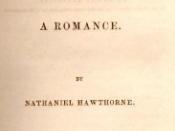The expression ÃÂcrime does not payÃÂ lies at the heart of much literature and is present in many films as well as in everyday life. True to the expression, in most novels, criminals are eventually punished, even for crimes that are nowadays not considered wrong. However they do not always receive a fair punishment. I believe this is to make the story more attention-grabbing and to arouse the readerÃÂs sympathy and pity for the criminal when he is too severely punished and vice versa. The reader feels more emotionally drawn to the character. In texts I have studied this year this unjustness is often apparent, especially in ÃÂThe Scarlet LetterÃÂ by Nathaniel Hawthorne.
This novel tells the tale of a recently married young woman who is sent to America to start a new life there. Her husband, Roger Chillingworth, is soon to follow her but two years later there is still no news of him.
To the shame of the strictly Puritan community, Hester then bears an illegitimate child, named Pearl. As means of punishment she is forced to wear a letter ÃÂaÃÂ signifying ÃÂadulteressÃÂ on her breast for the rest of her life. She also has to stand on the village scaffold for three hours to be mocked. Here Hester notices her husband watching her. However he conceals his identity, presumably to hide his shame. He then visits her in her brief stay in prison, under pretext that he is a doctor. Roger demands to know the name of PearlÃÂs father but Hester refuses to tell him. This renders him furious and he threatens to kill this man if she tells a soul about their meeting. He then starts his obsessive search of PearlÃÂs father.
Hester is ÃÂrejected from societyÃÂ and therefore lives with Pearl (ÃÂin...


